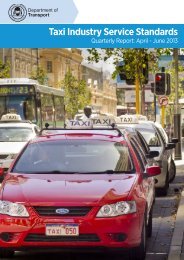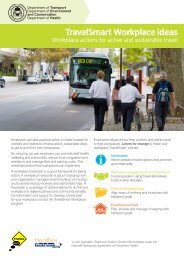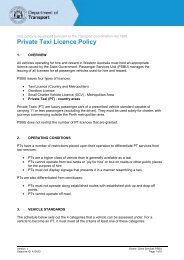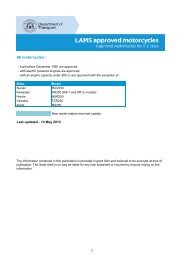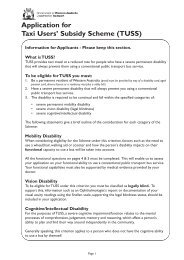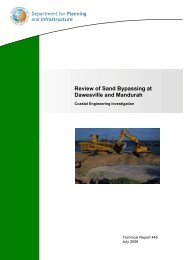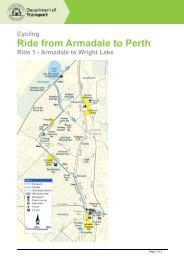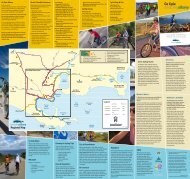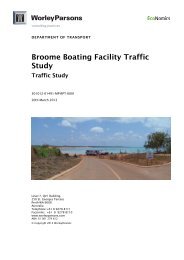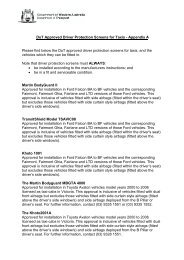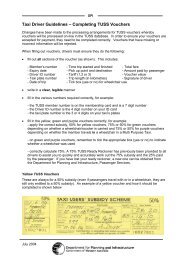Department of Transport Annual Report 2010 - 2011
Department of Transport Annual Report 2010 - 2011
Department of Transport Annual Report 2010 - 2011
Create successful ePaper yourself
Turn your PDF publications into a flip-book with our unique Google optimized e-Paper software.
(ii) Provisions – other<br />
Employment on-costs<br />
Employment on-costs, including workers’ compensation insurance, are not<br />
employee benefits and are recognised separately as liabilities and expenses<br />
when the employment to which they relate has occurred. Employment on-costs<br />
are included as part <strong>of</strong> ‘Other expenses’ and are not included as part <strong>of</strong> the<br />
<strong>Department</strong>’s ‘Employee benefits expense’. The related liability is included in<br />
‘Employment on-costs provision’.<br />
See note 9 Other Expenses and note 28 Provisions.<br />
(t) Superannuation expense<br />
The superannuation expense in the Statement <strong>of</strong> Comprehensive Income comprises<br />
<strong>of</strong> employer contributions paid to GSS (concurrent contributions), the West State<br />
Superannuation Scheme (WSS), and the GESB Super Scheme (GESBS). The<br />
employer contribution paid to the GESB in respect <strong>of</strong> the GSS is paid back into the<br />
Consolidated Fund by the GESB.<br />
The GSS Scheme is a defined benefit scheme for the purposes <strong>of</strong> employees<br />
and whole-<strong>of</strong>-government reporting. However, it is a defined contribution plan for<br />
agency purposes because the concurrent contributions (defined contributions)<br />
made by the agency to GESB extinguishes the agency’s obligation to the related<br />
superannuation liability.<br />
(u) Resources received free <strong>of</strong> charge or for nominal cost<br />
Resources received free <strong>of</strong> charge or for nominal cost that can be reliably measured<br />
are recognised as income and as assets or expenses as appropriate, at fair value.<br />
Where the resource received represents a service that the <strong>Department</strong> would<br />
otherwise pay for, a correspondng expense is recognised.<br />
Where assets or services are received from another State Government agency, these<br />
are separately disclosed under Income from State Government in the Statement <strong>of</strong><br />
Comprehensive Income.<br />
(v) Jointly controlled assets<br />
Interests in jointly controlled assets have been reported in the financial statements.<br />
The <strong>Department</strong>’s interest in jointly controlled assets is disclosed in note 40 Jointly<br />
controlled assets.<br />
(w) Comparative figures<br />
Comparative figures are, where appropriate, reclassified to be comparable with the<br />
figures presented in the current financial year.<br />
3. Disclosure <strong>of</strong> changes in accounting policy and estimates<br />
Initial application <strong>of</strong> an Australian Accounting Standard<br />
The <strong>Department</strong> has applied the following Australian Accounting Standards effective<br />
for annual reporting periods beginning on or after 1 July 2009 that impacted on the<br />
<strong>Department</strong>:<br />
2009-5 Further Amendments to Australian Accounting Standards arising from<br />
the <strong>Annual</strong> Improvements Project [AASB 5, 8, 101, 107, 117, 118, 136 &<br />
139] Under amendments to AASB 117, the classification <strong>of</strong> land elements<br />
<strong>of</strong> all existing leases has been reassessed to determine whether they<br />
are in the nature <strong>of</strong> operating or finance leases. As leases <strong>of</strong> land &<br />
buildings recognised in the financial statements have not been found to<br />
significantly expose the department to the risks/rewards attributable to<br />
control <strong>of</strong> land, no changes to accounting estimates have been included<br />
in the Financial Statements and Notes to the Financial Statements.<br />
Under amendments to AASB 107, only expenditures that result in a<br />
recognised asset are eligible for classification as investing activities in<br />
the Statement <strong>of</strong> Cash Flows. All investing cashflows reported in the<br />
<strong>Department</strong>’s Statement <strong>of</strong> Cash Flows relate to increases in recognised<br />
assets.<br />
59



